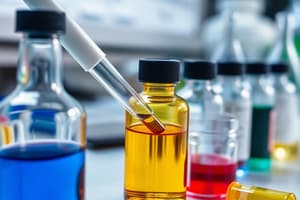Podcast
Questions and Answers
What is forensic toxicology primarily concerned with?
What is forensic toxicology primarily concerned with?
- Study of poisons in specific occupations
- Medicolegal aspects of poisoning (correct)
- Intended therapeutic use of substances
- Effects of toxins on the environment
Which of the following correctly describes a poison?
Which of the following correctly describes a poison?
- A substance with low toxicity used for therapeutic purposes
- Only substances that are solid in form
- Any substance causing ill health or death through any route (correct)
- Only chemical compounds found dangerous in the workplace
What does 'Sola dosis facit venenum' imply in toxicology?
What does 'Sola dosis facit venenum' imply in toxicology?
- Only high doses of drugs are harmful
- Medicinal substances never cause harm
- All substances are inherently toxic
- The amount of a substance determines its toxicity (correct)
How does the absorption rate of poisons vary by route?
How does the absorption rate of poisons vary by route?
Which term describes the study of poisons in relation to specific occupations?
Which term describes the study of poisons in relation to specific occupations?
Which of the following best distinguishes a toxin from a venom?
Which of the following best distinguishes a toxin from a venom?
What distinguishes a drug from a poison?
What distinguishes a drug from a poison?
Which category includes substances produced by living organisms that are harmful?
Which category includes substances produced by living organisms that are harmful?
Which type of poisoning is characterized by pinpoint pupils and respiratory depression?
Which type of poisoning is characterized by pinpoint pupils and respiratory depression?
What is a common clinical feature of sympathomimetic poisoning?
What is a common clinical feature of sympathomimetic poisoning?
Which of the following toxic syndromes typically leads to urinary retention?
Which of the following toxic syndromes typically leads to urinary retention?
What clinical triad is associated with morphine poisoning?
What clinical triad is associated with morphine poisoning?
What would most likely suggest oxalic acid/ethylene glycol poisoning during lab investigations?
What would most likely suggest oxalic acid/ethylene glycol poisoning during lab investigations?
In which toxic syndrome would you expect an increase in gastrointestinal motility?
In which toxic syndrome would you expect an increase in gastrointestinal motility?
Which feature is commonly associated with anticholinergic poisoning?
Which feature is commonly associated with anticholinergic poisoning?
Which of the following features is NOT typically associated with opioid poisoning?
Which of the following features is NOT typically associated with opioid poisoning?
Which preservative is ideal for blood analysis?
Which preservative is ideal for blood analysis?
What is the main disadvantage of using formalin in chemical analysis?
What is the main disadvantage of using formalin in chemical analysis?
Which of the following is not a preservative for urine samples?
Which of the following is not a preservative for urine samples?
What preservation method can safely avoid contamination for deeply frozen samples?
What preservation method can safely avoid contamination for deeply frozen samples?
Which preservative is preferred for virology studies?
Which preservative is preferred for virology studies?
What type of poison is associated with causing maximum tissue destruction?
What type of poison is associated with causing maximum tissue destruction?
Which of the following is NOT classified as an irritant?
Which of the following is NOT classified as an irritant?
Which of the following examples is classified as a cardiotoxin?
Which of the following examples is classified as a cardiotoxin?
Which of the following types of poisons primarily induce asphyxia?
Which of the following types of poisons primarily induce asphyxia?
What type of neurotoxin is known to cause delirium?
What type of neurotoxin is known to cause delirium?
Which of the following is a common plant source of irritants?
Which of the following is a common plant source of irritants?
Which of the following substances would be classified as a neurotoxin acting on the spinal cord?
Which of the following substances would be classified as a neurotoxin acting on the spinal cord?
Which of the following is classified as a simple asphyxiant?
Which of the following is classified as a simple asphyxiant?
Which organ should be preserved when Digitalis poisoning is suspected?
Which organ should be preserved when Digitalis poisoning is suspected?
What color indicates the presence of Sodium amytal?
What color indicates the presence of Sodium amytal?
Which of the following is the most reliable sample for analysis in suspected poisoning cases?
Which of the following is the most reliable sample for analysis in suspected poisoning cases?
What should be preserved from the small intestine?
What should be preserved from the small intestine?
For which poison is the preservation of hair particularly important?
For which poison is the preservation of hair particularly important?
What organ is suggested for preservation when poisoning by cerebral poisons is suspected?
What organ is suggested for preservation when poisoning by cerebral poisons is suspected?
Which organ's preservation is crucial for detecting metallic poisons like Thallium?
Which organ's preservation is crucial for detecting metallic poisons like Thallium?
In the case of suspected Strychnine poisoning, which organ should be preserved?
In the case of suspected Strychnine poisoning, which organ should be preserved?
What is the characteristic odor associated with cyanide?
What is the characteristic odor associated with cyanide?
Which poison produces a skin color of cherry red upon hypostasis?
Which poison produces a skin color of cherry red upon hypostasis?
What is the stomach mucosa appearance associated with sulphuric acid?
What is the stomach mucosa appearance associated with sulphuric acid?
Which of the following poisons is recognized for producing a garlic odor?
Which of the following poisons is recognized for producing a garlic odor?
What color is typically observed in the skin due to nitrites during hypostasis?
What color is typically observed in the skin due to nitrites during hypostasis?
What is the expected skin color from poisoning with phosphorous?
What is the expected skin color from poisoning with phosphorous?
The odor of burnt rope is associated with which poison?
The odor of burnt rope is associated with which poison?
Nitric acid poisoning leads to what kind of stomach mucosa coloration?
Nitric acid poisoning leads to what kind of stomach mucosa coloration?
Flashcards
Toxicology
Toxicology
The study of poisoning, including the source, properties, how it works in the body, signs and symptoms, diagnosis, and treatment.
Forensic Toxicology
Forensic Toxicology
Focuses on the legal aspects of poisoning, like reports, procedures for collecting samples, and post-mortem findings.
Occupational Toxicology
Occupational Toxicology
Examines the effects of poisons found in a particular workplace.
Eco-toxicology
Eco-toxicology
Signup and view all the flashcards
Poison
Poison
Signup and view all the flashcards
Sola dosis facit venenum
Sola dosis facit venenum
Signup and view all the flashcards
Drug
Drug
Signup and view all the flashcards
Poison
Poison
Signup and view all the flashcards
Corrosive Poisons
Corrosive Poisons
Signup and view all the flashcards
Irritant Poisons
Irritant Poisons
Signup and view all the flashcards
Neurotoxins
Neurotoxins
Signup and view all the flashcards
Cardiotoxins
Cardiotoxins
Signup and view all the flashcards
Asphyxiants
Asphyxiants
Signup and view all the flashcards
What are corrosive poisons?
What are corrosive poisons?
Signup and view all the flashcards
What are irritant poisons?
What are irritant poisons?
Signup and view all the flashcards
What are neurotoxins?
What are neurotoxins?
Signup and view all the flashcards
Saturated Sodium Chloride Solution
Saturated Sodium Chloride Solution
Signup and view all the flashcards
Rectified Spirit
Rectified Spirit
Signup and view all the flashcards
Sodium Fluoride and Potassium Oxalate
Sodium Fluoride and Potassium Oxalate
Signup and view all the flashcards
Preservatives for Urine
Preservatives for Urine
Signup and view all the flashcards
Glycerol for Virology
Glycerol for Virology
Signup and view all the flashcards
Substance appearance
Substance appearance
Signup and view all the flashcards
Chemical analysis in poisoning
Chemical analysis in poisoning
Signup and view all the flashcards
Key organs for poison analysis
Key organs for poison analysis
Signup and view all the flashcards
Stomach in poisoning
Stomach in poisoning
Signup and view all the flashcards
Small intestine, liver, and kidneys in poisoning
Small intestine, liver, and kidneys in poisoning
Signup and view all the flashcards
Target organs for poison analysis
Target organs for poison analysis
Signup and view all the flashcards
Preservatives for poisoned organs
Preservatives for poisoned organs
Signup and view all the flashcards
Quantity of organs to be preserved
Quantity of organs to be preserved
Signup and view all the flashcards
Cyanide Odor
Cyanide Odor
Signup and view all the flashcards
Hydrogen sulfide Odor
Hydrogen sulfide Odor
Signup and view all the flashcards
Carbon monoxide Hypostasis
Carbon monoxide Hypostasis
Signup and view all the flashcards
Cyanide Hypostasis
Cyanide Hypostasis
Signup and view all the flashcards
Phosphorous Hypostasis
Phosphorous Hypostasis
Signup and view all the flashcards
Stomach Mucosa - Sulphuric Acid
Stomach Mucosa - Sulphuric Acid
Signup and view all the flashcards
Stomach Mucosa - Nitric Acid
Stomach Mucosa - Nitric Acid
Signup and view all the flashcards
Stomach Mucosa - Arsenic
Stomach Mucosa - Arsenic
Signup and view all the flashcards
What is a Toxicodrome?
What is a Toxicodrome?
Signup and view all the flashcards
What are the characteristics of Cholinergic toxicodrome?
What are the characteristics of Cholinergic toxicodrome?
Signup and view all the flashcards
What are the characteristics of Anticholinergic toxicodrome?
What are the characteristics of Anticholinergic toxicodrome?
Signup and view all the flashcards
What are the characteristics of the Opioid/Sedative Toxicodrome?
What are the characteristics of the Opioid/Sedative Toxicodrome?
Signup and view all the flashcards
What are the characteristics of Sympathomimetic toxicodrome?
What are the characteristics of Sympathomimetic toxicodrome?
Signup and view all the flashcards
What does presence of Oxalate Crystals in Urine suggest?
What does presence of Oxalate Crystals in Urine suggest?
Signup and view all the flashcards
What Lab Finding Suggests Phenol Poisoning?
What Lab Finding Suggests Phenol Poisoning?
Signup and view all the flashcards
What is the Significance of Uniformly Worsening Symptoms in Poisoning?
What is the Significance of Uniformly Worsening Symptoms in Poisoning?
Signup and view all the flashcards
Study Notes
General Toxicology
- Study of poisoning, including sources, properties, mechanisms, signs, symptoms, diagnosis, and management
- Acute poisoning is a medical emergency
- A significant cause of morbidity and mortality worldwide
- A leading cause of suicide
Basic Terms
- Forensic Toxicology: Medico-legal aspects of poisoning
- Medico-legal reporting
- Gastric lavage
- Post-mortem findings
- Preserving samples
- Poison: Any substance (solid, liquid, or gas) that causes harm (local or remote action) through oral, injectable, inhalation, or direct contact
- Rapid Absorption: Inhalation > Intravenous > Intramuscular
- Drug vs. Poison: "The dose makes the poison." (Paracelsus)
- Toxin vs. Venom:
- Toxin: Biological substance produced by living organisms (plant or animal)
- Venom: Toxin produced by an animal; a proteinaceous substance injected into the body causing ill effects.
- Occupational Toxicology: Study of workplace exposure to poisons
- Eco-toxicology: Study of toxins in the environment
Classification of Poisons (Mnemonic: CINCAM)
- Corrosives: Cause tissue destruction (acids, alkalis)
- Irritants: Cause inflammation
- Neurotoxins: Affect the brain and nervous system
- Cardiotoxins: Affect the heart
- Asphyxiants: Inhibit respiration
- Miscellaneous Poisons: Variety of other poisons
Diagnosis of Poisoning (In Living People)
- Symptoms: Sudden onset, uniform worsening, similar symptoms in family members
- History of recent intake/exposure
- Features of specific toxidromes (cholinergic, anticholinergic, opioid, sedative-hypnotics, sympathomimetics)
- Vital signs: Temperature, blood pressure, heart rate
- Other: Bowel sounds, urination, tremors
- Lab Investigations: Blood, urine (oxalate casts)
- Suggestive of oxalic acid/ethylene glycol poisoning
- Proximal convoluted tubule (PCT) necrosis → Phenol
Ideal Homicidal vs. Suicidal Poison
- Homicidal: Colorless, odorless, tasteless, cheap, delayed onset, mimics natural disease
- Suicidal: Pleasant taste, unimportant onset, immediate, painless death
Preservatives for Poison Analysis
- Saturated solution of sodium chloride
- Rectified spirit (95% alcohol)
- Used for chemical analysis
Studying That Suits You
Use AI to generate personalized quizzes and flashcards to suit your learning preferences.




